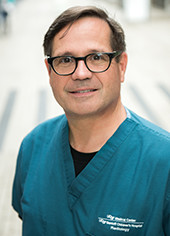UCSF Radiology Tech Discusses Cutting-Edge Technology and Patient Care
 Mark How, radiology tech working with patients using the PET/MRI device, shares his perspective on UCSF's cutting-edge technology and the high quality of patient care:
Mark How, radiology tech working with patients using the PET/MRI device, shares his perspective on UCSF's cutting-edge technology and the high quality of patient care:
“I strive to give patients not only high-quality imaging, but a high-quality experience. At UCSF Imaging at China Basin, we provide patients with cutting-edge technology and immediately transfer their images to some of the best minds in radiology who staff our clinics and work in our research department.
"Cutting-edge radiology means being able to see a patient’s condition more clearly, while exposing them to the lowest amount of radiation. Simultaneous PET/MRI is very advanced. The fact that these studies can be conducted together gives us an advantage that we don’t see with single-imaging modalities. Further, novel pharmaceuticals with lower doses can now replace the older, higher-dose medications used as imaging agents. Combining that with MRI technology also helps minimize radiation exposure. Pediatric patients especially benefit from having much lower exposure. The same is true of cancer patients who need continuous therapy. They benefit by getting multiple scans at once with much less radiation exposure."
For more stories about PET/MRI imaging in clinical practice, please click here.
Mark How is principal nuclear medicine technologist at the University of California, San Francisco. He received his master’s degree in Radiologic Health Physics from San Jose State University, and served as a senior nuclear medicine technologist beginning in 2006.
